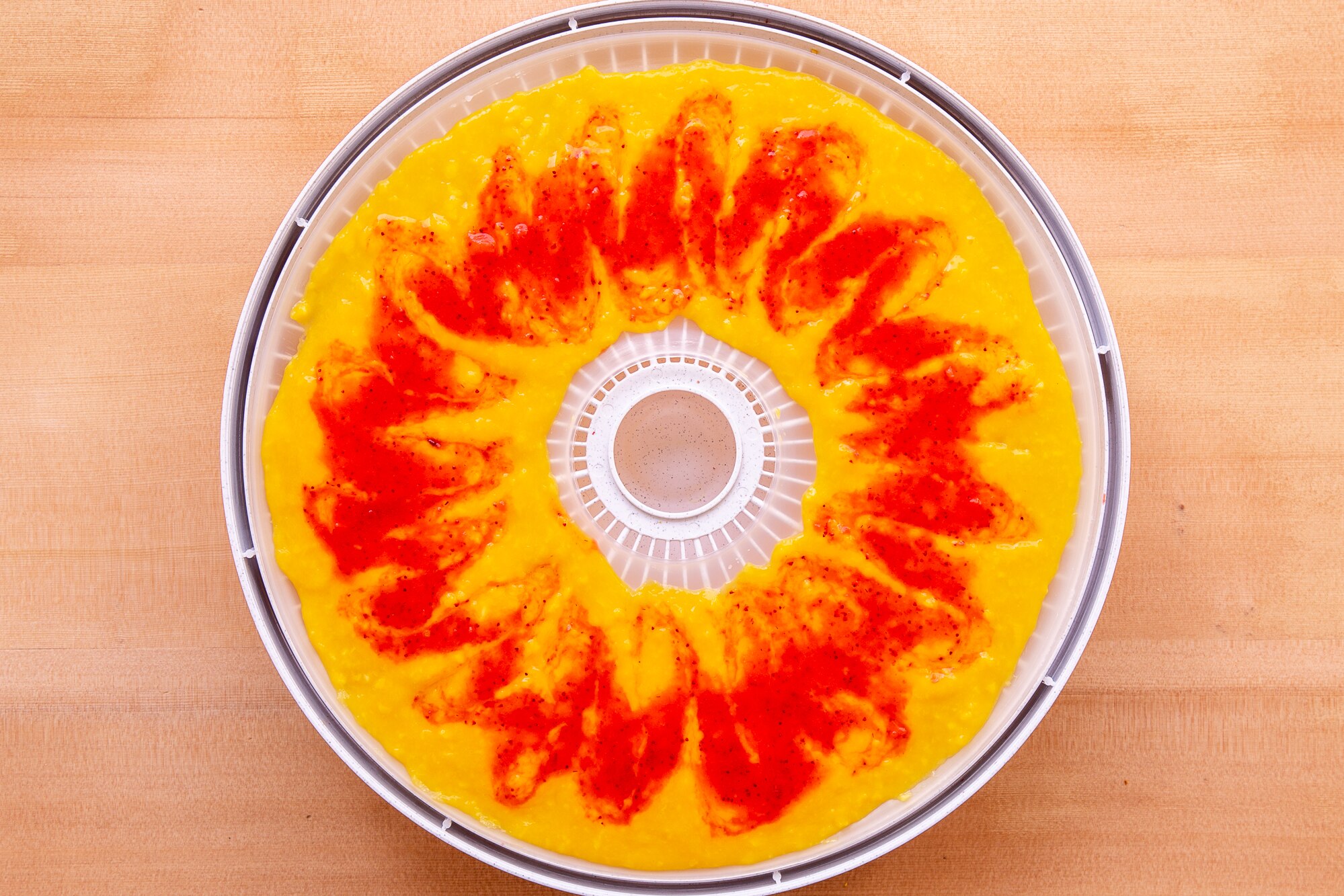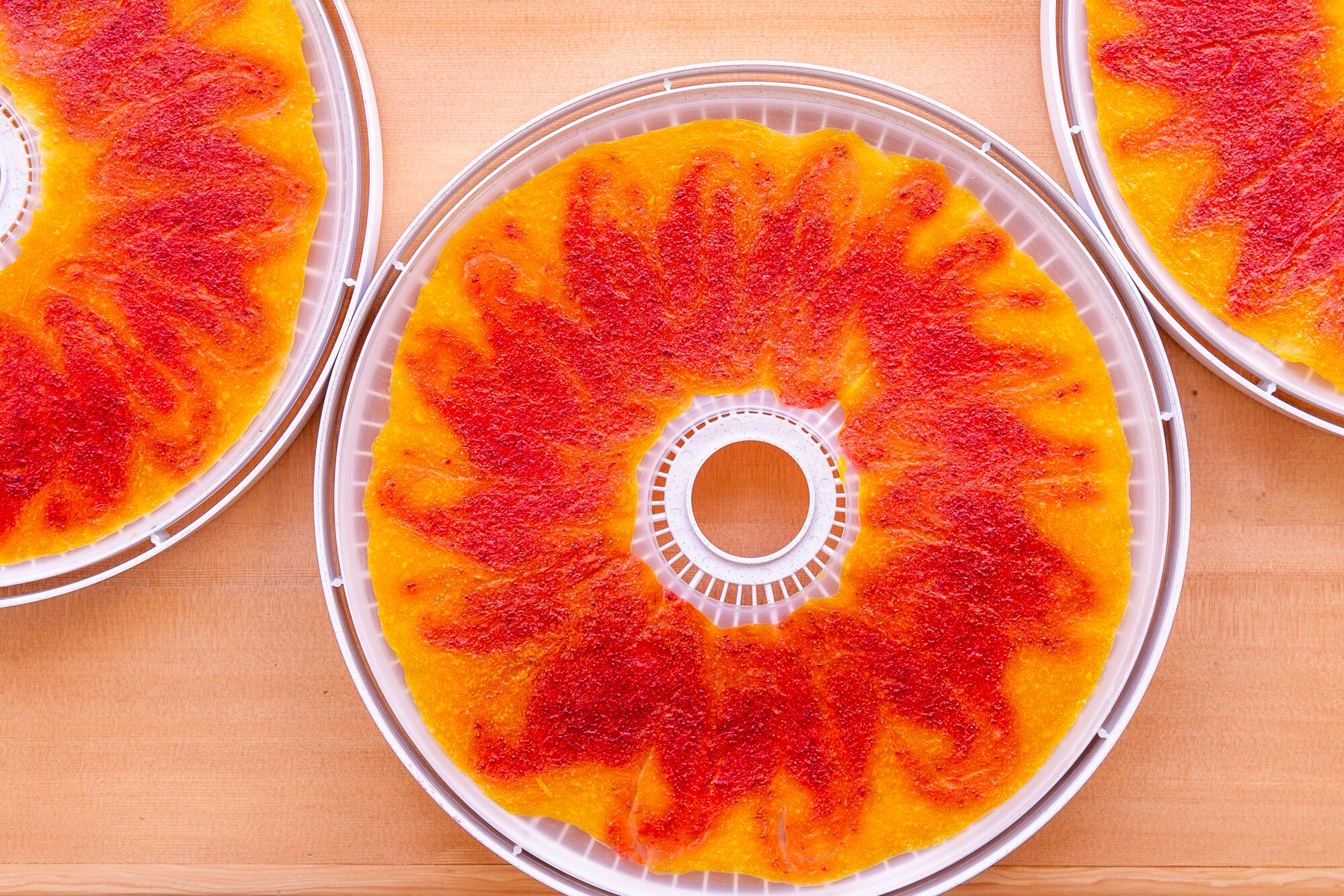A tropical swirl of color and flavor, this homemade strawberry-mango fruit leather is a healthier version of the popular '90s snack.
During the winter, when the weather is dark and gloomy, we find ourselves craving a taste of summer—something bright, light and sunny to remind us of warmer times! So a few years ago we started making homemade fruit leathers and they have quickly become one of our favorite winter traditions.

Fruit leathers are best made in an actual dehydrator. The ideal cook temperature is 135 F and most home ovens can't consistently maintain a temperature that low. Even with the oven door cracked open, the heating is uneven at best. So if you don't have one already, consider picking up a relatively inexpensive dehydrator if you want to make this recipe.
Fresh fruit is always ideal, but in the depths of winter, that's not always a viable option. So the next best choice is to pick up flash-frozen fruit from the freezer section. Just make sure the fruit is completely thawed before starting.
To get the tie-dye effect for this recipe, we did our fruit in two different batches. In a food processor or blender, put your mangoes and the juice of half a lemon, and blend until smooth. Pour the puree into a bowl, clean the food processor, and then repeat for the strawberries.
On your dehydrator sheets, wipe a thin layer of coconut oil with a paper towel. This step is really important to prevent the final product from sticking to the tray and potentially tearing it.
Using an offset spatula, start with one of your fruit purees (we started with the mango) and spread out a layer. You're looking to make an even layer that is roughly 1/8 inch thick. Any thinner and your fruit leather will become brittle, any thicker and it will have a hard time fully drying. Once the mango layer is down, using a fork to create swirls of strawberry and smooth out to the same thickness as the mango. A little jiggle of the tray can help the puree "settle" into a more even layer.

Place inside the dehydrator and set to 135 F. Unlike other dehydrator recipes, it is possible to over dehydrate fruit leathers. If left in too long they will become very hard and brittle. So we recommend doing this recipe in the morning and checking it periodically throughout the day. We found our fruit leather had to run for about 6 to 10 hours before fully setting, depending on how cold the fruit puree was when we started.
You will know when they are done when they're uniformly dry to the touch on top and no longer tacky.
So if you're looking to perk up your winter so with some tropical fun, give this tie-dye fruit leather a try!
Camping Snack: Tie-Dye Fruit Leather Recipe
Makes 12 servings
Prep time: 15 minutes of preparation; 6 to 10 hours of dehydrating time
Ingredients
- 1 pound frozen mangoes, thawed
- 1/2 pound frozen strawberries, thawed
- 1/2 lemon, juiced
- Coconut oil
- 1 tablespoon sugar, optional
Directions
Step 1
Thaw the frozen fruit. Place the mangoes (and any accumulated juices), lemon juice, and sugar (optional) into a food processor and blend until smooth. Transfer into a bowl and set aside. Wipe or rinse the food processor bowl.
Step 2
Place the strawberries (and any accumulated juices) into a food processor and blend until smooth. Transfer into a bowl.
Step 3
Lightly oil a dehydrator fruit leather tray and pour enough mango puree to create a 1/8 inch thick layer (the exact amount will depend on the size of your dehydrator trays). Using an offset spatula is helpful in evening out the mixture.
Step 4
Pour strawberry puree on top of the mango puree. If your trays are circle, pouring it in a circle in the middle of the tray works best. If your trays are rectangular or square, pour in straight horizontal lines. Using a fork, swirl the strawberry into the mango to create designs. Repeat with remaining trays/puree.
Step 5
Dehydrate at 135 F for 6 to 10 hours, checking periodically after 4 hours to monitor progress. The leathers are done when the fruit is no longer soft or tacky but is not yet brittle.
Step 6
Remove leathers from the trays, cut, and roll for storage. Store in an airtight container.

